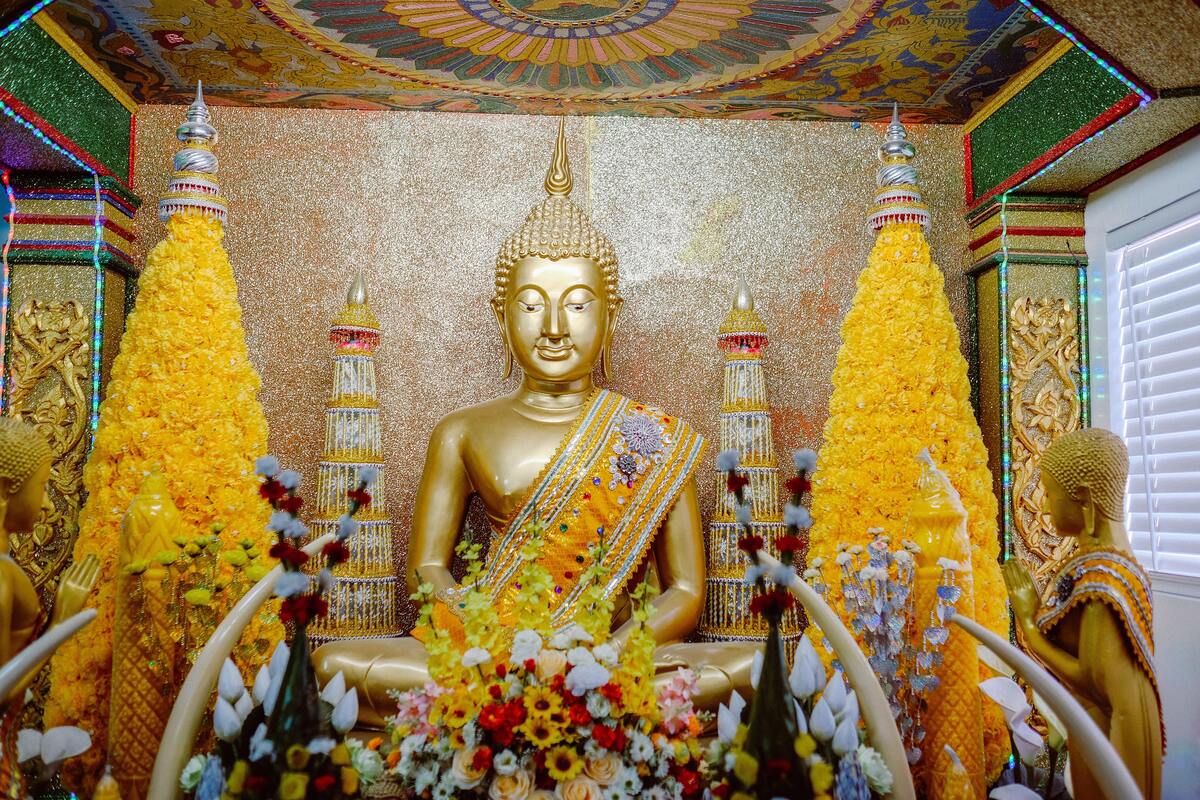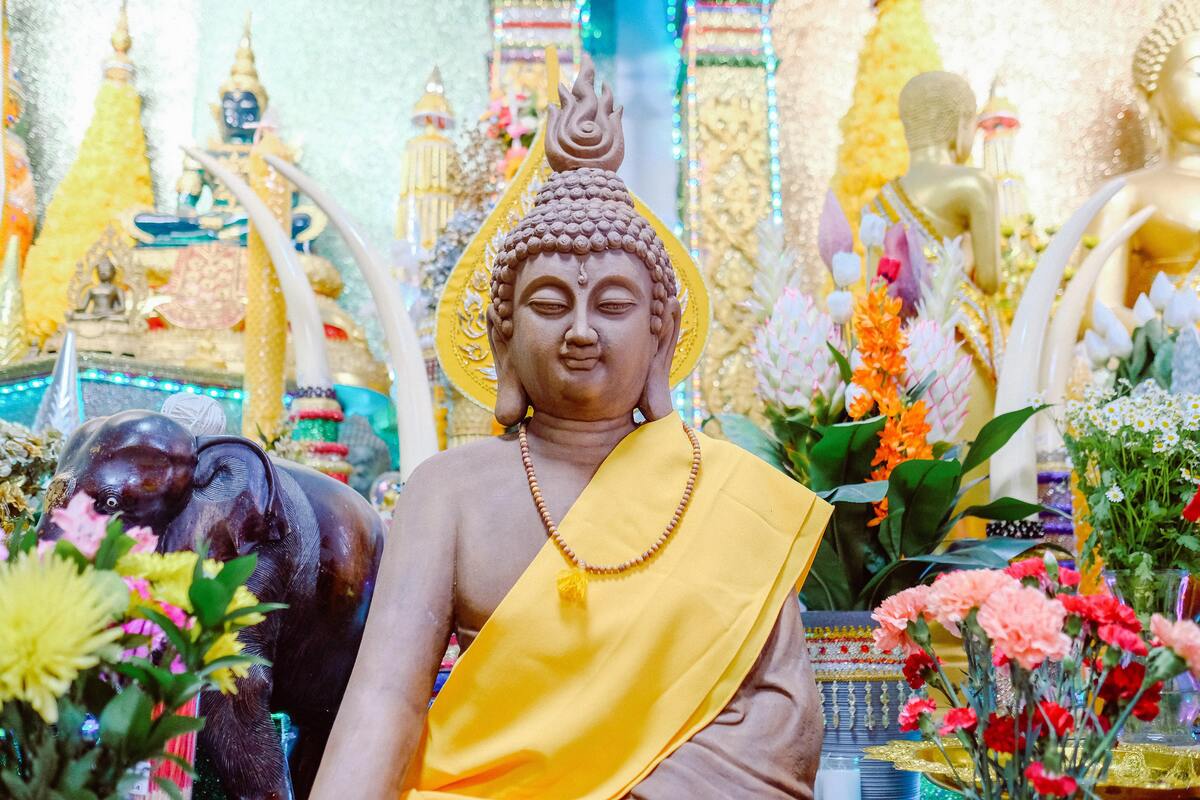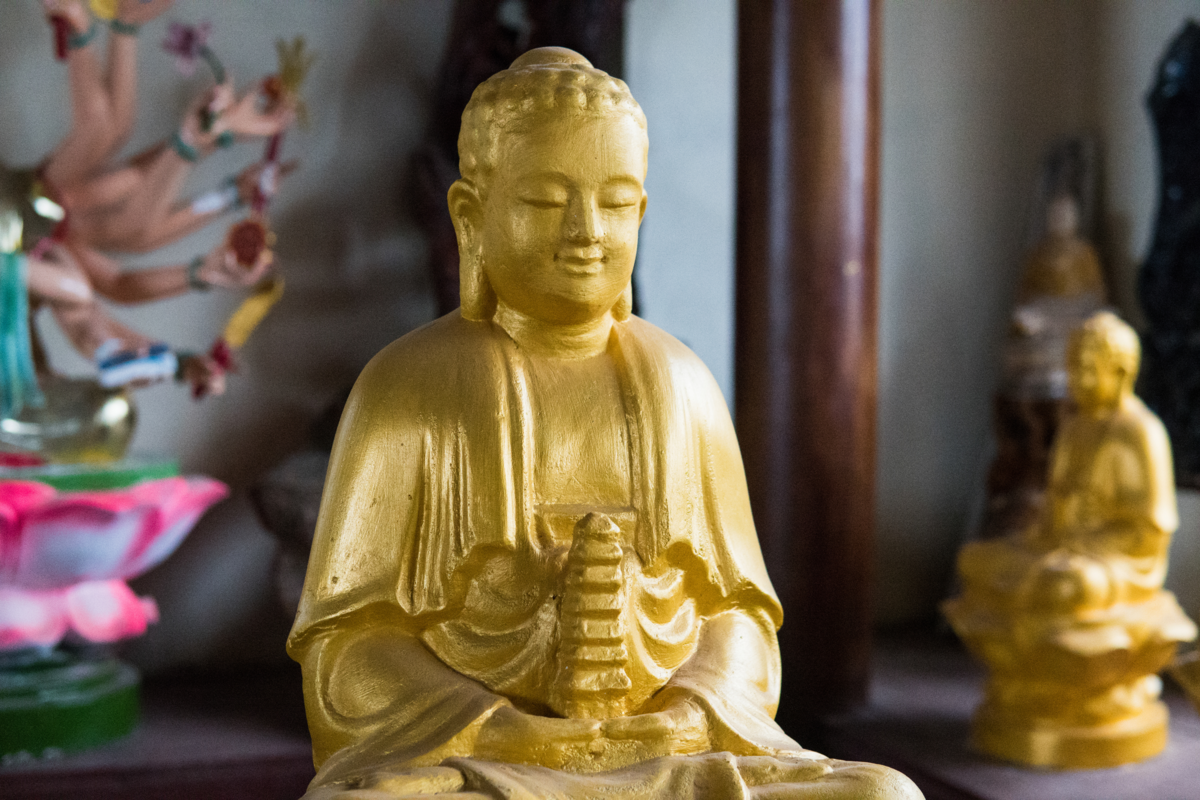Table of contents
What is the middle way?

The middle path is a path to reach enlightenment and detach from suffering. This path takes into consideration four noble truths and eight principles, and these teachings guide the entire process of self-knowledge and lead to the attainment of nirvana.
In this logic, the middle way provides a great transformation, which occurs gradually as the individual undertakes to follow the teachings of Buddhism. All this knowledge was formulated and transmitted by Shakyamuni Buddha, the historical Buddha, who after his enlightenment dedicated himself to teaching everything he had learned.
Currently, the middle way is followed by Buddhists and sympathizers, in search of balance and peace of mind. Discover below what is the middle way in Buddhism, its history, the 4 noble truths, the 8 principles and much more!
Middle way and its history

The middle way is part of the Buddhist philosophy developed by Shakyamuni Buddha. Being nothing more than a set of teachings to achieve enlightenment, Below, understand better what is the middle way in Buddhism, what is Buddhism and more.
What is Buddhism?
Buddhism is a religion and philosophy founded by Siddhartha Gautama, the historical buddha. This religion holds that enlightenment or nirvana can be attained in this life, and for this one must follow the middle path.
In this logic, the word "Buddha" means one who has awakened from the sleep of ignorance. Therefore, Buddha is actually a state of mind. Furthermore, unlike other religions, in Buddhism there is no God.
History of Buddhism
Buddhism originated in India, approximately 528 B.C., founded by Prince Siddhartha Gautama, the historical Buddha. It is a religion and philosophy that aims to cease suffering through enlightenment. Although it originated in India, it has spread to other countries. Thus, today, Buddhism is most present in East Asia, while in India, the most popular religion is theHinduism.
In addition, Buddhist philosophy is associated with Hinduism, which helped spread the teachings of Siddhartha Gautama. Buddhism arose when Shakyamuni Buddha, after attaining enlightenment, decided to pass on everything he had learned up to that time. For teaching purposes, Buddha created the 4 noble truths and the 8 principles to follow the middle path.
In Buddhism, there is the concept of Samsara, a cycle of birth, existence, death and rebirth. Thus, when this cycle is broken it is possible to reach enlightenment. Currently, Buddhism is among the 10 largest religions in the world, and new adherents to Buddhist philosophy are always appearing.
Therefore, Buddhism is a path to seek nirvana. To follow it, it is necessary to accept that suffering exists, so that its causes can be understood, with the intention of breaking the wheels of samsara.
The Middle Way in Buddhism
The middle way in Buddhism is related to finding balance and control in one's own actions and impulses, but it does not mean having a passive attitude towards life. On the contrary, the middle way makes you more awake.
In order to do so, one's thoughts and behaviors should be aligned with the well-being of others as well as one's own happiness. In order to pass on his teachings, Shakyamuni Buddha (Siddhartha Gautama) developed the 8 principles for living on the middle path.
To reach enlightenment Buddha used methods of excessive control, in this, he even fainted after a fast. After this experience, Buddha realized that he should not act at the extremes, but rather, seek the middle path.
Story of Siddhartha Gautama
Buddhist tradition tells that Siddhartha Gautama, the historical buddha, was born in southern Nepal at the beginning of the Mágada period (546-424 B.C.) Siddhartha was a prince, so he lived amidst luxury, but nevertheless decided to abandon everything to seek something deeper.
He took this decision because he knew he needed to leave his comfort zone, since he was dissatisfied with the futility of his life. So, at first, he joined the Brahmin monks, trying to find answers to suffering through fasting and penance.
In time, he realized that he had to change direction and went on alone, seeking the middle way. To reach enlightenment, Siddhartha sat, in meditation, for seven weeks at the foot of a fig tree. After that, he traveled throughout central India to pass on his knowledge. He continued in this direction until the time of his death, at the age of 80, in the city of Kushinagar, India.
The death of muda is called parinirvana, this means that he has fulfilled his work as a buddha. Moreover, after the Buddha's death, new Buddhist schools emerged, such as Nikaya and Maaiana.
The four noble truths

The four noble truths explain the states of consciousness present in the universe, so to understand them is also to detach oneself from suffering and all forms of illusion.
They are regarded as noble truths because they cannot be understood by just anyone, only by those who can pass from illusion to enlightenment. Find out what the four noble truths are below.
What are noble truths?
When Shakyamuni Buddha attained enlightenment, he realized that he should teach what he had experienced. However, he realized that passing on this knowledge would not be an easy task. Therefore, he formulated the four noble truths to introduce the experience he had when he became enlightened.
In this sense, the four noble truths are: truth of suffering, truth of the origin of suffering, truth of the cessation of suffering, and truth of the path that leads to the cessation of suffering. They were organized in this way because, in many situations, human beings first perceive the effect before understanding the cause.
The first noble truth
The first noble truth highlights that life is full of suffering, birth is a suffering, and so is aging. In addition, throughout life various other types of sufferings are experienced.
If it is a fact that suffering exists, it would be easier to accept it. However, most beings are incessantly searching for happiness and trying to get away from what hurts. Even the search for something pleasurable can become exhausting. This is because life is in constant transformation, so ideas change quickly.
In addition, sufferings can be internal, those that are part of an individual, and external, those that do not depend on a single person. Examples of internal sufferings are fear, anxiety, anger, among others. On the other hand, external sufferings can be wind, rain, cold, heat, and so on.
The second noble truth
The second noble truth is that suffering is caused by attachment to illusion. Human beings find it difficult to leave the world of illusion, so they go through difficult processes in which they chain themselves to something that is not true.
Situations change constantly, so living in a world of illusions, without any control, generates deep imbalances. Thus, it is common to feel fear and powerlessness as changes occur.
The third noble truth
The third noble truth reveals that it is possible to be free from suffering. To do this, one must attain nirvana or enlightenment. This state goes far beyond anger, greed, suffering, the duality between good and evil, and so on. However, it is not possible to describe the process in words, it is something that must be lived.
The mind can become broad, sensitive, aware, and more present. Someone who attains enlightenment no longer suffers from impermanence, because he no longer identifies with what is born and dies. Illusion ceases to exist, so life becomes lighter.
Feeling anger and identifying with it is very different from just observing that feeling. In this logic, when someone is able to perceive what they feel, without identification, a sense of peace and freedom is achieved. Being that, according to Buddha, peace is the highest level of happiness one can have.
The fourth noble truth: the middle way
The fourth noble truth is that you can cease suffering even in this lifetime. So, to follow the path to enlightenment, you need to follow the eight principles of the middle way, one of which is to maintain the correct viewpoint. You see, it's not about right or wrong, here, the word "correct" means clarity to observe that everything is connected, as well as that life is constant impermanence.
Observing this dynamic and accepting it, makes life lighter and without so many attachments. To reach nirvana it is necessary to develop the right understanding. In this logic, many people want to justify their actions, instead of changing them.
By understanding what caused that behavior and learning how to transform it, life takes another shape.
Another important point is to keep right thinking, cultivating kindness and empathy, thus, moving away from selfishness and negative thoughts. In addition, it is necessary to have the right speech, for this, you need to be truthful, not use slanderous words and be encouraging.
Eight principles of the middle way

The eight principles are a series of steps to be followed that lead to enlightenment. Buddha said that in order to cease suffering it is necessary to understand it, because only in this way is it possible to prevent its constant repetition. Discover below what are the eight principles of the middle way.
Legend
Buddhist legend has it that before following the middle way, Siddhartha Gautama went through an extremely strict fast, during which he fainted from hunger. He received help from a peasant girl passing by, who offered him a bowl of porridge.
Afterwards, Siddhartha meditated on what had happened, realizing that excessive control also distances one from spirituality. Therefore, he chose to follow the middle path, the same path that enabled him to reach enlightenment.
Correct view
To have the correct vision is simply to look at life as it is, that is, without being carried away by illusions. In this logic, when the world vision does not correspond to reality, everything tends to become more difficult.
This is because illusions constantly crumble due to impermanence, so not facing reality as it is brings a lot of suffering. On the other hand, when the vision is correct it is easier to deal with changes, as well as to make the right choices.
Right Thinking
Thoughts can turn into actions, in this sense, correct thinking leads to coherent decisions, consequently, it keeps suffering away and provides peace of mind. On the other hand, unconscious thoughts can generate misaligned actions and countless sufferings.
Also, thought is energy, so cultivating the good side of life helps to emanate positivity. Thus, keeping the right thoughts is essential even in the midst of problems.
Appropriate verbal expression
A wise person is one who knows how to use his words according to the moments and people present. It does not mean that there is control, but rather, attention and empathy to direct the right words.
However, this does not mean that one should only say nice messages, on the contrary, sometimes words can be unpleasant, but necessary. Therefore, it is essential to speak the truth.
Most of the time, people defend ideas that they do not put into practice. Thus, their words are correct, but their intentions are not. Thus, everything they say becomes a lie. In this logic, the middle way seeks to establish a balance between what is said and what is done.
Correct Action
The correct actions encompass all human behaviors, thus, it includes eating habits, work, studies, the way you treat other people, among other possibilities.
A correct action concerns not only other people, but also other beings and the environment. A correct action is always fair, so it takes into account the collective. Therefore, selfish behavior must be avoided.
Correct way of life
The right way of life is linked to one's profession, so to follow the middle way it does not matter what one's occupation is, but if one follows Buddhist principles. In this logic, at work it is fundamental not to violate morality, not to harm others, nor to influence someone to act in a wrong way.
If a job violates the Buddha's teachings, it is important to rethink the way you work, or even seek a new occupation. This is because work produces a lot of karma, thus hindering you from following a path of balance.
Adequate commitment
The appropriate commitment indicates that in order to achieve inner enlightenment, you need to put in a lot of effort. This means that you need to put in a lot of energy and focus in this direction.
The results of the efforts appear gradually, and upon reaching nirvana, the person is faced with absolute peace. Therefore, the appropriate commitment corresponds to dedication and application in the process of self-knowledge.
Appropriate observation
Proper observation is linked to concentration. Many people believe that to be concentrated on something is to focus on one thing only. However, this practice instead of liberating imprisons the mind.
Life is impermanence, so it is necessary to observe carefully and establish what is important. In this sense, it is necessary to pay attention to the goals and dreams that cross your mind, and select those that really lead to personal growth. That which no longer adds up should be discarded.
Proper Meditation
Proper meditation talks about performing the practice in the best way possible, thus, enjoying all its benefits. Conversely, meditation done incorrectly, is not effective.
Without the correct meditation an individual can fall into the same sufferings several times. Thus, meditation is an indispensable step to ascend to higher levels of consciousness, understand one's own life and tread the middle path.
Is it possible to find balance and control in our lives?

According to Buddhism, it is possible to stop suffering and find control while still in this life. Buddhism also believes in reincarnation, with these cycles happening constantly throughout life. In this sense, try to remember the various stages you've already had, so you'll realize that parts no longer exist.
As bad as it may be to think this way, actually understanding impermanence and the connection with all that exists is the beginning of a more balanced life. Therefore, it is possible to reach enlightenment, but it requires changes in behavior in order to follow the middle path.

